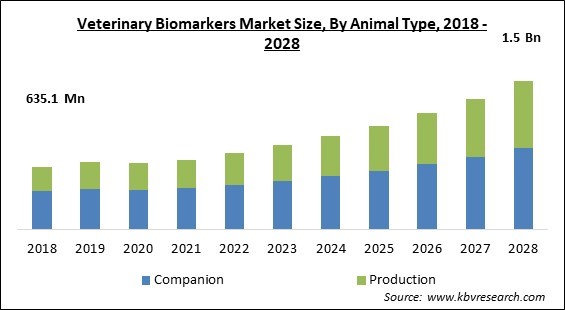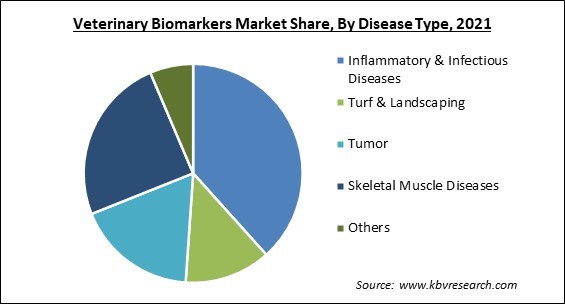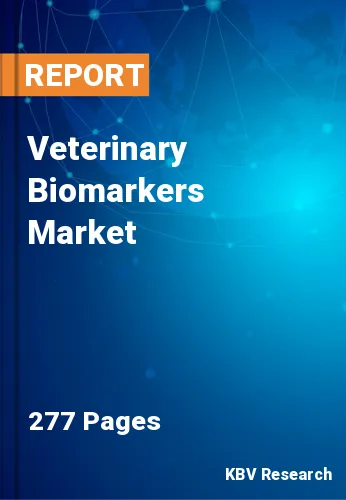The Global Veterinary Biomarkers Market size is expected to reach $1.5 billion by 2028, rising at a market growth of 11.7% CAGR during the forecast period.
Biomarkers are sensors of biological processes and pathological conditions that can indicate a variety of characteristics associated with health and disease. This assessment often consists of a molecule (such as a hormone or cell surface receptor) that can be found in blood or other tissues and, in general, represents the overall health of a patient is in. For instance, the measurement of a biomarker may reveal the activity of a metabolic pathway or the amount of protein expression that may be connected to the development of a disease like diabetes, pancreatitis, or cancer, to name a few.

Clinical medicine uses biomarkers specifically for risk assessment, disease diagnosis, prognostication, therapy response monitoring, and relapse detection. Biomarkers are very essential in medical and veterinary research because they help characterize human and animal diseases. With the rising importance of human medicine, biomarkers are also of interest in veterinary medicine, where they may help not only with the early identification of disease but also with disease monitoring in patients, both during and after therapy.
Biomarkers may play the largest role in cancer medicine, much like they do in human medicine. A few biomarkers have been studied in veterinary oncology both in vitro and in vivo, particularly for canine hemangiosarcoma (HSA). Additionally, a commercial blood test for canine lymphoma (LSA) is currently available. Depending on its intended usage, a good veterinary biomarker should have specific properties and characteristics. It needs to be precise, sensitive, and particular.
The biomarker should change as per the applicable disease and be able to distinguish between patients and healthy controls. The biomarker should also be quantified in a reliable and repeatable manner. For diagnostic purposes, it is preferable to extract biomarkers from readily available animal body fluids such as blood plasma, urine, perspiration, and saliva, as well as other reachable materials like hair and excrement. The proper evaluation of clinical responses to therapy and the direction of treatment program decisions are both made possible by the identification and quantification of biomarkers.
The American Veterinary Medical Association claims that providing veterinary care during the pandemic has proven difficult for veterinarians in the United States. However, veterinary clinics have long been seen as a crucial part of the nation's healthcare system. Additionally, healthcare systems focused more of their resources on urgent situations, which had an impact on animal diagnostic tests. Moreover, the supply chain for meats and other dietary items generated from animals was disrupted during the pandemic. As a result, fewer food items originating from animals were consumed, which had an impact on the sector.
The rising prevalence of zoonotic and foodborne diseases will affect the growth of the market. Like COVID-19, around three-quarters of novel and emerging infectious diseases in humans are zoonotic, meaning they can spread from animals to people. The leaders from G-7 countries called for "affordable and equitable access to diagnostics" as well as strengthening the 'One Health' strategy, which brings together veterinary, medical, and environmental disciplines in a collaborative effort to combat COVID-19 and future pandemics. According to estimates made before the current pandemic, zoonosis cause 2.5 billion cases of human sickness and 2.7 million fatalities annually.
Pet therapy is a general phrase that covers both therapeutic animal-assisted activities and other animal-assisted pursuits. Dogs or other animals are used in the emerging field of animal-assisted therapy to support individuals in healing from or better coping with health issues like heart disease, cancer, and mental health disorders. On the other hand, animal-assisted activities serve a more broad function, such as comforting and entertaining nursing home residents. This has gained momentum after its successful impact on people suffering from PTSD.
Most developing nations even lack proper human health services. In such cases, the expectation of the provision of biomarkers on animals still remains a futuristic idea. In many sections of developing countries, the issue is not how to create new, more efficient diagnostic tools, medications, or immunizations. Instead, more efficient veterinary service organizational structures are more crucial than improved diagnostic techniques. Community-based animal health workers, who reside in the livestock-keeping communities and offer the neighborhood animal’s affordable "first aid" for the efficient control of diseases, are another example of more necessary services.

On the basis of animal type, the market for veterinary biomarkers is bifurcated into companion animals (Dogs, Cats, and Others) and production animals. The companion animals segment acquired the highest revenue share in the veterinary biomarkers market in 2021. This is a result of both the considerable disease prevalence rates that were seen in dogs and the increased adoption rates for canines. It also decisively stated that cats outnumbered dogs as pets.
Based on product type, the veterinary biomarkers market is segmented as biomarkers, kits & reagents and biomarker readers. The biomarkers, kits, and reagents segment recorded the maximum revenue share in the veterinary biomarkers market in 2021. This is due to the widespread availability of popular brands of biomarkers and test kits introduced by influential market participants. To comprehend the disorder's course and to offer targeted treatments that specifically target the disease's biological indicator, veterinarians choose sensitive and accurate disease diagnostic methods using biomarker test kits.
On the basis of application, the market for veterinary biomarkers is classified as disease diagnostics, preclinical research, and others. The preclinical research segment witnessed a significant revenue share in the veterinary biomarkers market in 2021. This is because veterinary biomarkers and post-genomic technologies are the subjects of more and more study and development. The prospect for segment expansion is being further enhanced by the cutting-edge techniques adopted by key players in the animal health industry to identify novel biomarkers or disease indicators.
Based on disease type, the veterinary biomarkers market is categorized as inflammatory & infectious diseases, Turf & Landscaping, skeletal muscle diseases, tumor, and others. The tumor segment garnered a promising revenue share in the veterinary biomarkers market in 2021. Biomarkers will undoubtedly continue to develop into useful diagnostic tools, especially for conditions like cancer, but a single screening method by itself cannot and should not take the place of a thorough physical and diagnostic examination.
| Report Attribute | Details |
|---|---|
| Market size value in 2021 | USD 704 Million |
| Market size forecast in 2028 | USD 1.5 Billion |
| Base Year | 2021 |
| Historical Period | 2018 to 2020 |
| Forecast Period | 2022 to 2028 |
| Revenue Growth Rate | CAGR of 11.7% from 2022 to 2028 |
| Number of Pages | 277 |
| Number of Tables | 530 |
| Report coverage | Market Trends, Revenue Estimation and Forecast, Segmentation Analysis, Regional and Country Breakdown, Companies Strategic Developments, Company Profiling |
| Segments covered | Animal Type, Disease Type, Product Type, Application, Region |
| Country scope | US, Canada, Mexico, Germany, UK, France, Russia, Spain, Italy, China, Japan, India, South Korea, Singapore, Malaysia, Brazil, Argentina, UAE, Saudi Arabia, South Africa, Nigeria |
| Growth Drivers |
|
| Restraints |
|
On the basis of region, the veterinary biomarkers market can be categorized across North America, Europe, Asia Pacific, and LAMEA. The North America procured the largest revenue share in the veterinary biomarkers market in 2021. The significant presence of key players, the adoption of various strategies developed by key companies to increase market penetration, rising research activities, rising diagnostic rates, rising animal population, and rising veterinary care costs are all factors that contribute to the region's high share.
Free Valuable Insights: Global Veterinary Biomarkers Market to reach USD 1.5 Billion by 2028
The market research report covers the analysis of key stake holders of the market. Key companies profiled in the report include Zoetis, Inc., Merck & Co., Inc., Virbac, IDEXX Laboratories, Inc., MI:RNA Diagnostics Ltd., Mercodia AB, Antech Diagnostics, Inc. (Mars, Inc.), Avacta Animal Health Limited (Vimian Group), Life Diagnostics, Inc., and Acuvet Biotech.
By Animal Type
By Disease Type
By Product Type
By Application
By Geography
The Veterinary Biomarkers Market size is projected to reach USD 1.5 billion by 2028.
Rising Incidents Of Zoonotic Diseases And Facilitation Of Research are driving the market in coming years, however, Differences In Veterinarian Services Among Developed And Developing Nations restraints the growth of the market.
Zoetis, Inc., Merck & Co., Inc., Virbac, IDEXX Laboratories, Inc., MI:RNA Diagnostics Ltd., Mercodia AB, Antech Diagnostics, Inc. (Mars, Inc.), Avacta Animal Health Limited (Vimian Group), Life Diagnostics, Inc., and Acuvet Biotech.
The expected CAGR of the Veterinary Biomarkers Market is 11.7% from 2022 to 2028.
The Inflammatory & Infectious Diseases segment acquired maximum revenue share in the Global Veterinary Biomarkers Market by Disease Type in 2021 thereby, achieving a market value of $548.4 million by 2028.
The North America market dominated the Global Veterinary Biomarkers Market by Region in 2021, and would continue to be a dominant market till 2028; thereby, achieving a market value of $544.9 million by 2028.
Our team of dedicated experts can provide you with attractive expansion opportunities for your business.

